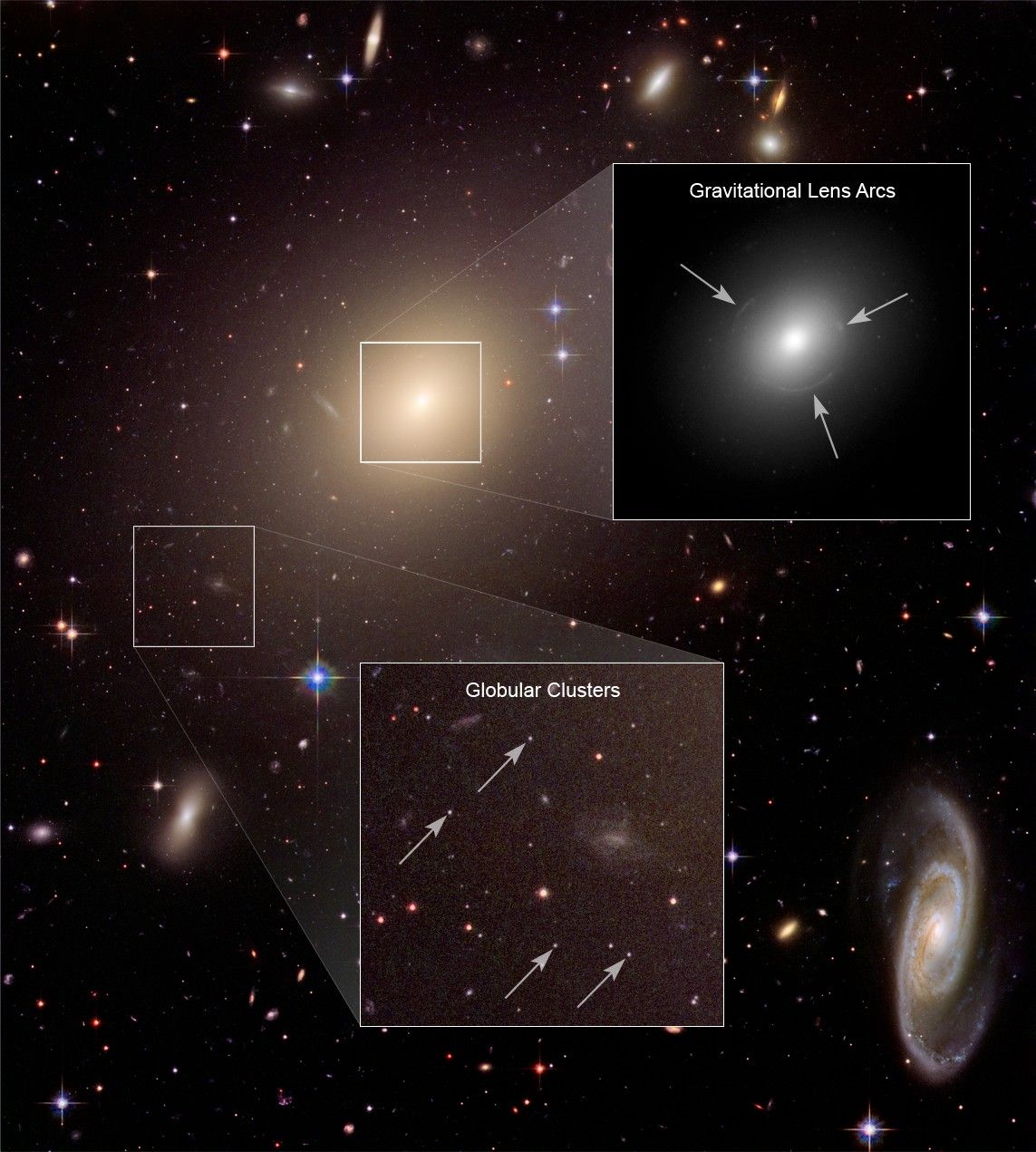1 min read
ESO 325-G004: Detailing the Big Picture

Evident from the Hubble image is the fact that ESO 325-G004 is home to thousands of globular clusters, small compact groups of hundreds of thousands of stars that are gravitationally bound systems. These clusters are dispersed spherically and uniformly in the outer halo of the elliptical and make their way around the center of the galaxy over the course of millions of years. Several foreground stars and background galaxies are also visible within the halo of this bright galaxy.
In the course of analyzing this Hubble image, astronomers discovered that the galaxy ESO325-004 is actually a "gravitational lens." This means that the focusing power of the enormous mass making up the galaxy causes the light from some background object, probably a distant "dwarf" galaxy, to be deflected and magnified. As a result, the more distant galaxy appears brighter, and distorted into the shape of an arc, or ring, known as an "Einstein ring" because the phenomenon was first predicted by Albert Einstein. Although the universe is filled with galaxies, gravitational lensing is a rare occurrence because it requires an almost perfect alignment of a distant galaxy with an intervening one that has enough mass to gravitationally focus the light.
This particular system is unique because it is closest known example of strong gravitational lensing. The galaxy is close enough that the dynamics of its stars can be studied in detail using spectrographs on large ground-based telescopes. The spectrographs reveal how fast the stars in the galaxy are moving, and this allows astronomers to estimate how much mass must be present in the center of the galaxy. This estimate can in turn be compared to the amount of mass needed to produce the observed gravitational lensing effect. In this way, astronomers can build up a detailed, self-consistent picture of the matter distribution and dynamics of this unique nearby lensing system.
About the Object
- R.A. PositionR.A. PositionRight ascension – analogous to longitude – is one component of an object's position.13h 43m 33.3s
- Dec. PositionDec. PositionDeclination – analogous to latitude – is one component of an object's position.-38° 10' 33.99"
- ConstellationConstellationOne of 88 recognized regions of the celestial sphere in which the object appears.Centaurus
- DistanceDistanceThe physical distance from Earth to the astronomical object. Distances within our solar system are usually measured in Astronomical Units (AU). Distances between stars are usually measured in light-years. Interstellar distances can also be measured in parsecs.Approximately 463 million light-years (142 Megaparsecs)
- DimensionsDimensionsThe physical size of the object or the apparent angle it subtends on the sky.The galaxy cluster image is roughy 2.9 arcminutes (385,000 light-years or 120 kiloparsecs) wide.
About the Data
- Data DescriptionData DescriptionProposal: A description of the observations, their scientific justification, and the links to the data available in the science archive.
Science Team: The astronomers who planned the observations and analyzed the data. "PI" refers to the Principal Investigator.The Hubble image was created from HST data from proposal 10429: PI: J. Blakeslee (Washington State University), J. Lucey and R. Smith (University of Durham), J. Tonry (University of Hawaii), and S. Mei (Johns Hopkins University); and 10710: K. Noll, H. Bond, C. Christian, L. Frattare, F. Hamilton, Z. Levay, M. Mutchler, W. Januszewski, and T. Royle (Hubble Heritage Team/STScI), and J. Blakeslee (Washington State University). - InstrumentInstrumentThe science instrument used to produce the data.HST>ACS/WFC
- Exposure DatesExposure DatesThe date(s) that the telescope made its observations and the total exposure time.January 2005 - February 2006
- FiltersFiltersThe camera filters that were used in the science observations.F475W (g), F625W (r), and F814W (I)
- Object NameObject NameA name or catalog number that astronomers use to identify an astronomical object.ESO 325-G004, Abell S0740
- Object DescriptionObject DescriptionThe type of astronomical object.Giant Elliptical Galaxy and its Host Galaxy Cluster
- Release DateFebruary 5, 2007
- Science ReleaseHubble Illuminates Cluster of Diverse Galaxies
- Credit

The galaxy cluster image is a composite of many separate exposures made by the ACS instrument on the Hubble Space Telescope using several different filters. Three filters were used to sample broad wavelength ranges. The color results from assigning different hues (colors) to each monochromatic image. In this case, the assigned colors are: Blue: F475W (g) Green: F625W (r) Red: F814W (I)

Related Images & Videos

Hubble Illuminates Cluster of Diverse Galaxies
This image from NASA's Hubble Space Telescope shows the diverse collection of galaxies in the cluster Abell S0740 that is over 450 million light-years away in the direction of the constellation Centaurus. The giant elliptical ESO 325-G004 looms large at the cluster's center. The...
Share
Details
Claire Andreoli
NASA’s Goddard Space Flight Center
Greenbelt, Maryland
claire.andreoli@nasa.gov































